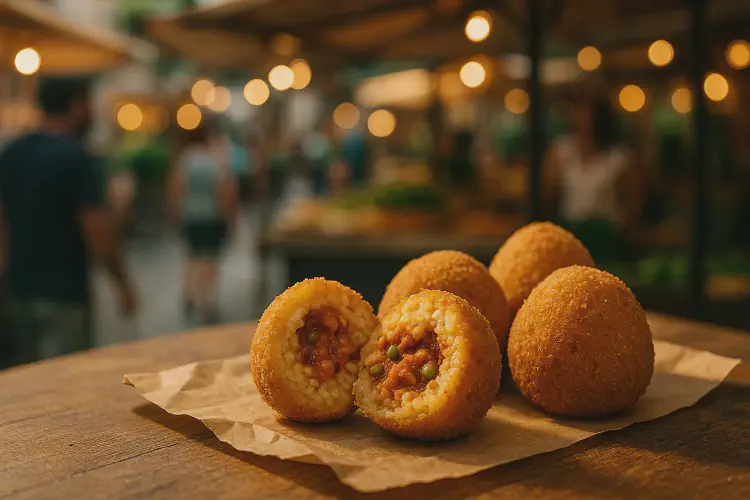Traditional Sicilian food guide
Sicilian cuisine is a vibrant reflection of the island’s history — a fusion of **Greek, Arab, Norman, and Spanish influences** blended with fresh local ingredients and Mediterranean sunshine. Known for its bold flavors, sweet-and-sour contrasts, and deep connection to the land and sea, Sicilian food is among the most diverse and beloved in Italy.
- Visit Sicily
- 3 min read

Traditional Sicilian Food Guide — Flavors of the Mediterranean
🍋 Overview
Sicily’s cuisine is a story told through sun, sea, and history. Every dish carries the memory of past civilizations: the Greeks brought olives and wine, the Arabs introduced citrus, almonds, and sugar, while the Spanish added tomatoes and chocolate. The result is a cuisine that is both rustic and sophisticated — a feast for the senses.
🥖 Key Characteristics of Sicilian Cuisine
- Mediterranean ingredients: olive oil, capers, tomatoes, garlic, and fresh herbs.
- Sweet and sour flavors: a balance of vinegar, sugar, and citrus typical of Arab heritage.
- Seasonal simplicity: recipes follow the rhythm of local harvests and fishing seasons.
- Street food culture: informal, affordable, and deeply traditional.
🍆 Classic Savory Dishes
1. Caponata
A sweet-and-sour eggplant stew made with capers, olives, celery, and tomato sauce — often served as a starter or side dish. Each region has its variation; some add pine nuts or raisins.
2. Arancini (or Arancine in Palermo)
Golden, deep-fried rice balls stuffed with ragù, peas, mozzarella, or ham. Originally designed as portable meals, arancini are now Sicily’s most famous street snack.
3. Pasta alla Norma
Named after Vincenzo Bellini’s opera Norma, this Catania-born classic combines fried eggplant, tomato sauce, basil, and ricotta salata cheese — a perfect example of Sicilian simplicity.
4. Pasta con le Sarde
A symbolic dish of spring, made with fresh sardines, wild fennel, pine nuts, raisins, and saffron. It captures the island’s blend of land and sea flavors.
5. Panelle and Cazzilli
Palermo street staples: panelle (chickpea fritters) and cazzilli (potato croquettes), typically served in bread rolls with lemon juice.
6. Sarde a Beccafico
Stuffed sardines with breadcrumbs, pine nuts, and raisins, rolled and baked — an elegant dish with humble origins.
🧀 Cheeses and Local Products
- Ricotta fresca: used in both savory dishes and desserts.
- Pecorino Siciliano DOP: aged sheep’s cheese with a tangy flavor.
- Caciocavallo Ragusano: stretched-curd cheese from the southeast.
- Olio d’oliva Siciliano: Sicily produces some of Italy’s finest olive oils, especially around Chiaramonte Gulfi and Noto.
🫒 Street Food and Local Specialties
Sicilian cities are open-air kitchens where tradition thrives:
- Pane con la milza (spleen sandwich): a Palermo specialty, rich and flavorful.
- Sfincione: a thick, spongy pizza topped with onions, anchovies, and breadcrumbs.
- Cannateddi and taralli: rustic snacks for festivals.
- Granita con brioche: shaved ice flavored with almond, lemon, or coffee — perfect for hot mornings.
🧁 Sweet Traditions
No food guide to Sicily is complete without desserts:
- Cannoli: crispy pastry tubes filled with sweet ricotta and chocolate chips.
- Cassata Siciliana: sponge cake layered with ricotta, candied fruit, and marzipan — influenced by Arab and Norman tastes.
- Frutta Martorana: almond paste shaped like realistic fruit.
- Granita: the original Sicilian ice dessert, smoother than shaved ice and often enjoyed with brioche.
🍷 Pairing with Sicilian Wines
Traditional dishes pair beautifully with local wines:
- Nero d’Avola: bold red, perfect with meat and pasta.
- Grillo and Inzolia: crisp whites for seafood.
- Marsala: sweet fortified wine for desserts and sauces.
🧭 Summary
Traditional Sicilian food is a living history of the island — a cuisine born from conquest, trade, and creativity. From humble street snacks to noble dishes and decadent sweets, every bite tells a story of Sicily’s sun-drenched landscapes and multicultural soul. Whether enjoyed in a Palermo market or a seaside trattoria, Sicilian cuisine embodies hospitality, heritage, and flavor without borders.